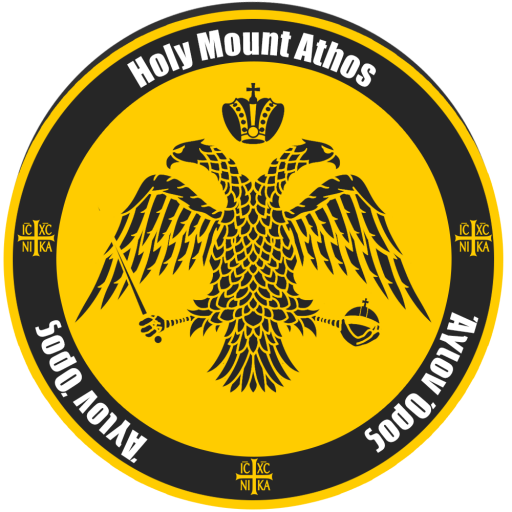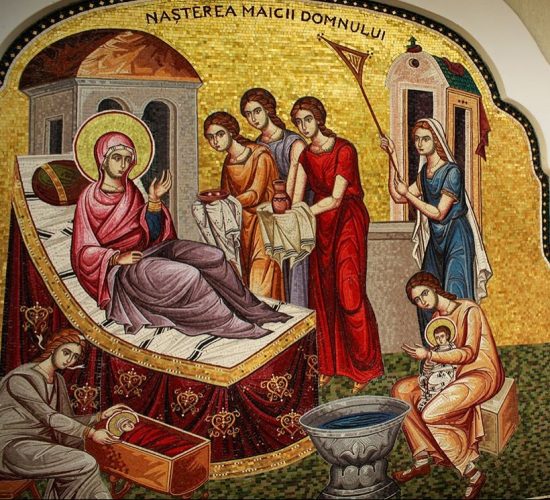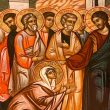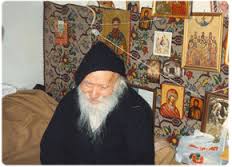The first significant celebration of the new church year is the Nativity of the Theotokos. This special feast dedicated to the Theotokos is observed on the eighth day of the new church year. The theological meaning of this celebration is closely tied to the fact that the Birth of the Holy Theotkos gives us a glimpse of the heavenly joy on the eighth day, which begins with the Resurrection of her Son, our Savior Jesus Christ, on the morning of His Resurrection. This aspect is beautifully expressed in the troparion of the feast: “Your Nativity, O Virgin, has proclaimed joy to the whole universe! The Sun of Righteousness, Christ our God, has shone from You, O Theotokos! By annulling the curse, He bestowed a blessing. By destroying death, He has granted us eternal Life. This “eternal life” refers to the unending day of the eighth day, which signifies a mode of existence beyond the constraints of matter and time, as described by Saint Maximus the Confessor.
From the troparion of the Feast of the Nativity of the Theotokos, we understand that the event in the history of salvation that we celebrate today is good news for the whole world. It is because from the one whose birth we honor, the “Sun of Righteousness, Christ our God,” has risen. It is He who, through His death and Resurrection, has undone the curse that befell humanity due to the disobedience of our first parents, Adam and Eve.
Drawing from the troparion of this feast, Father George Florovsky offers theological insight: “Even the birth of the Theotokos, in a certain way, belongs to the mystery of salvation (as expressed in the troparion of the feast). Christian thoughts do not remain at the level of abstract ideas but always seek the personal dimension of events.”
The fact that this celebration marks the beginning of significant feasts throughout the new church year emphasizes the importance of liturgical time. Father Placide Deseille speaks about the significance of commencing the church year, stating, “The Liturgy and the entire liturgical cycle are not merely a part of our Christian life, but rather, this entire liturgical cycle should shape our entire spiritual life, our life as Christians. It is the primary source of our Christian existence.” From this, we grasp the significance of liturgical time for us and gain a deeper understanding of why the first feast of the church year is dedicated to the Theotokos. Moreover, if we delve further, we discover that we conclude the church year with a day dedicated to honoring the Holy Virgin Mary: August 31st – the Placing of the Venerable Belt of the Mother of God in the shrine.
Regarding the historical celebration of the Nativity of the Theotokos on September 8th, we learn from Father Professor Ene Branişte: “The origins of this feast can be traced back to a period between the Third Ecumenical Council (431) and the Fourth Ecumenical Council (451)… Similar to the feast of the Dormition, it initially commemorated the annual consecration of a Church in Jerusalem dedicated to the Theotokos, constructed between 430 and 480, upon the site believed to be the house of the Holy Virgin’s parents according to tradition.”
On September 8th, we honor the wondrous Nativity of the Most Theotokos and Ever-Virgin Mary. From this moment, begins the holy life of she who was deemed worthy to be the Mother of the Lord. A concise definition of her existence filled with divine grace is given by Father Archimandrite Zaharia Zaharou from Essex: “The life of the Theotokos was prophetic, for she was not only overshadowed by the Holy Spirit at the Annunciation but was also filled with the Holy Spirit. More precisely, she was carried and guided by the Holy Spirit.” All of this is revealed in the marvelous history of the Holy Virgin Mary, as testified by the same Father Archimandrite: “The Birth of the Mother of God was itself a miracle. Her parents were barren, but righteous and faithful. Their life of prayer and sanctity caused a barren womb to bring forth a glorious fruit, the Mother of God.” We learn about this miracle from an apocryphal text called the “Protoevangelium of James.” From here, we know that the names of the parents of the Holy Theotokos were Joachim and Anna. They had Davidic lineage, meaning they were of royal descent according to Jewish customs, and were shunned by their fellow countrymen because they had no children. From the apocryphal account, we know that they prayed and fasted in order to conceive a child.
The “Protoevangelium of James” recounts the miracle of the Birth of the Holy Virgin Mary as follows: “And behold, an Angel of the Lord came to her, saying, Anna, Anna, the Lord has heard your prayer, and you shall conceive, and shall bring forth…’ And behold, two Angels came to him and said, ‘Look, Joachim, your husband, is coming with his flocks.’ And an Angel of the Lord descended to Joachim, saying, ‘Joachim, Joachim, the Lord God has heard your prayer; go down hence; for, behold, your wife Anna shell conceive in her womb…’ And behold, Joachim came with his flocks, and Anna stood by the gate and saw Joachim coming, and she ran and hung upon his neck…And, her months were fulfilled and In the ninth month, Anna brought fourth. And she said to the midwife, ‘What have I brought fourth to?’ And she replied, ‘A daughter.’ And said Anna: ‘My soul has been magnified this day, and she laid her down.’ And the days having been fulfilled, Anna was purified, and gave the breast to the child, and called her name Mariám.
In an article published in the magazine “Pemptousia” (issue 21) dedicated to the celebration of the Birth of the Holy Theotokos, this angelophany is explained: “As we see in this account, the Birth of the Theotokos is announced by an Angel after a long period of barrenness for her parents. It is also an Angel who announces the birth of other biblical figures: Samson, Samuel, and John the Baptist. However, the Birth of the Theotokos is different because it is the renewal of Adam and the calling of Eve, and the source of incorruptibility through which we are sanctified and saved from death… (Glory of the Litya, 8th tone). Parallel to the Birth of the Most Holy, as we see in almost all the troparia of the service for the Birth of the Most Holy Theotokos, the holy hymnographers emphasize her role as the Mother of God. Furthermore, in the deliverance of Anna’s barrenness, we can glimpse – according to the teachings of the Fathers of the Church – the deliverance of the barrenness of human nature, which will delight in the fruits of divine grace. Today, this grace begins to bear fruit through the Birth of the Mother of God.
The prayers and fasting of the holy and righteous parents, Joachim and Anna, loosen the barrenness and bring forth the one who is “more honorable than the Cherubim and more glorious beyond compare than the Seraphim ” the Most Holy Virgin Mary, who was chosen by God to be the Mother of His Son, our Lord Jesus Christ. This is attested so clearly by the kontakion of today’s feast, in which we honor the Holy Mother: “. By Your Nativity, O Most Pure Virgin, Joachim and Anna are freed from barrenness; Adam and Eve, from the corruption of death. And we, your people, freed from the guilt of sin, celebrate and sing to you: The barren woman gives birth to the Theotokos, the nourisher of our life! ”
Reverent Ciprian Florin Apetrei
Source: ziarullumina.ro






